March 2019
 The Slavic Baroque is one of those tidal pools in the repertoire of Western music that sees relatively little tourist traffic. Such neglect is certainly undeserved and contradicts history itself since the Slavic lands were busy centers of music in the Baroque period. They attracted Italian and German musicians to their courts and the fine native composers absorbed creative currents from all over Europe. In this post I want to offer an appreciation of those composers of the Slavic Baroque I’ve come to know through recordings of their music I’ve added to my own collection. There are some real gems among them. Part 1 focuses on the Early Baroque. Part 2 will examine the High Baroque.
The Slavic Baroque is one of those tidal pools in the repertoire of Western music that sees relatively little tourist traffic. Such neglect is certainly undeserved and contradicts history itself since the Slavic lands were busy centers of music in the Baroque period. They attracted Italian and German musicians to their courts and the fine native composers absorbed creative currents from all over Europe. In this post I want to offer an appreciation of those composers of the Slavic Baroque I’ve come to know through recordings of their music I’ve added to my own collection. There are some real gems among them. Part 1 focuses on the Early Baroque. Part 2 will examine the High Baroque.
![]()
Adam Jarzębski (Polish, c. 1590-c. 1648)
Jarzębski is among the earliest Polish composers to attain high reputation, and deservedly so. If you didn’t have your biographical facts in hand you might think you’re listening to works from the early Italian baroque. That’s how masterfully he adopted the conventions of early Italian instrumental style. As it turns out he had good opportunity to do just that. From the liner notes of the CD of Jarzębski’s music I own comes this interesting information:
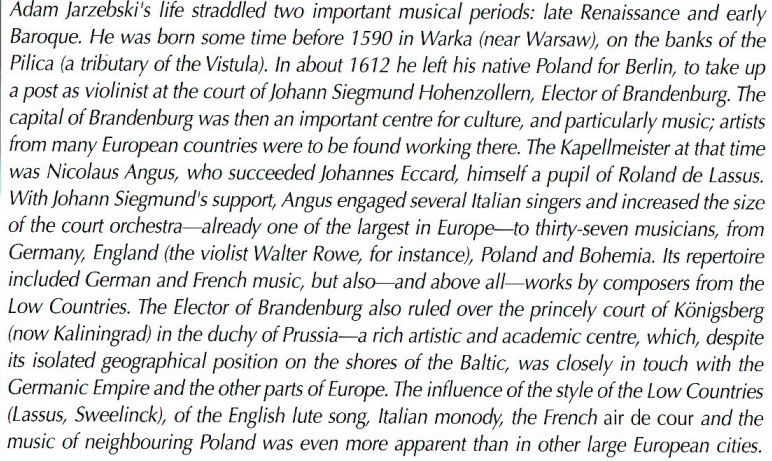
What an exciting and influence-rich musical environment. It brought all the major currents in European music to the doorstep and Jarzębski seized the opportunity. But even more excitement came later when he got the chance to travel to Italy for a period of study, as this information from the Polish Music Center (webpage here) explains:
In 1615 Jarzębski received leave of absence from his duties in the cappella and went to Italy, where he had the opportunity to acquaint himself with Italian music. We have no exact information as to when the composer became a member of the Chapel Royal of Sigismund III. The records of 1621 show that he had been engaged in this capella ab aliquot iam annis, and so he had probably joined it in 1619, directly after leaving the Elector’s cappella. Jarzębski remained in the cappella of Sigismund III, and afterwards Wladyslaw IV, until the end of his life, and whole of his musical output comes presumably from the period when he was working there. Thanks to his connections and his position at the Royal Court, Jarzębski’s importance increased among the rich Warsaw bourgeoisie. He became a member of the municipal patriciate of the capital and on 5th February 1648 the name of Jarzębski was included in the Regestrum civium juratorum Antiquae Varsaviae. In December 1648, after thirty years’ service at the Royal Court, Jarzębski dictated his last will and died probably shortly thereafter or in early 1649.
I know of only one recording of Jarzębski’s music, it’s on the Pierre Verany label performed by the French group Ensemble Mensa Sonora, They use original instruments and the recording is quite successful, rendering the music with the verve and rhythmic finesse it deserves. Here’s an image of the CD verso:

For anyone who loves the Canzoni of Girolamo Frescobaldi (as I do) or the Canzonets of Thomas Morley (all loveliness, every one of them) the addition of Jarzębski’s music to the available repertoire will be a great treat.
But Jarzębski had other talents up his sleeve in addition to a fine ear and good way with a pen on staff paper. This astonishing bit of information comes from the culture.pl page (here) on the composer:
In 1635 Jarzębski became the royal architect and began his career with designing the Ujazdów Castle. He was deeply appreciated by Zygmunt III, who endowed him with a few mills and lifelong authority over the small suburban village Piaseczno.
Surprise, surprise — I can’t think of any other musicians who branched out into architecture after becoming famous as a composer. Here’s a pic of the castle:
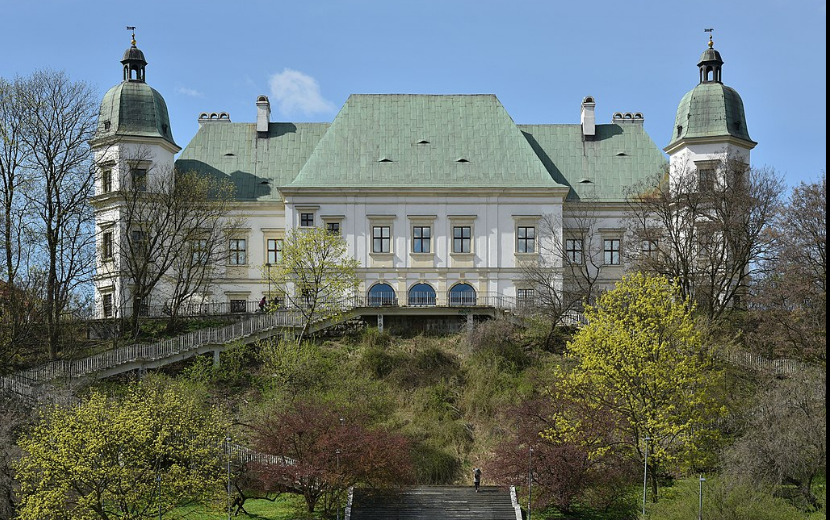
Hats off to Pan Jarzębski, who obviously did as well with a pen on architectural drawings as he did on staff paper. It’s a good point of departure for reminding ourselves how lively and accomplished the Slavic lands were in the Baroque period, as we shall see below.
![]()
Adam Václav Michna z Otradovic (Czech, ca. 1600–1676)
From the Wikipedia page on Michna (here) comes this biographical information:
Michna was descended from the noble and musical family of Michna z Ottradovic in Jindřichův Hradec in South Bohemia, bearing the title of Knight. His father was the organist and trumpeter Michael Michna (many of his other relatives were also trumpeters). In the 1620s the literary fraternity in the town was restored by the highest Lord Chancellor of the Kingdom of BohemiaVilém Slavata and that act, together with the activities of the Jesuit College, founded in 1594, contributed greatly to the development of cultural life in the town. Adam Michna became the first student at the Jesuit College, where he studied in 1611–1612 and 1615–1617 at the gymnasium. In the 17th and 18th centuries the Order of Jesuits was a great influence on musical life in the Czech lands. Many of Michna’s compositions were later printed and published by Prague Jesuits.
Michna’s importance in the history of Czech music is not reflected in any great revival of his works today. Unsurprisingly, most of the recordings of his music come from the Czech Republic. His work fall into two categories, religious songs and polyphonic church music (masses and litanies). He’s perhaps best known for his collection of religious songs entitled Loutna česká (= The Czech Lute) (1653). An interesting historical twist is associated with that collection, as the Wikipedia page explains:
The violin ritornelli, to be played between stanzas, had been lost and so were reconstructed for a 1998 edition by Michael Pospíšil for contemporary audiences. Then, in 2014, Czech musicologist Petr Daněk discovered the complete missing originals in the Franciscan library in Slaný. These proved to be unexpectedly complex and virtuosic, at variance with Pospíšil’s imagined fluid simplicity. According to Music Director Adam Viktora of Ensemble Inégal, a Czech music ensemble that in 2015 published a CD of the complete work recorded in Slaný, “The use of instruments in Michna’s Czech Lute was in effect much more restrained than has been generally assumed and practiced by musicians up till now.”
I have an earlier recording by Musica Bohemica under the direction of Jaroslav Krček. It uses Pospíšil’s reconstructions with a modern string orchestra. The result is not happy, as one might expect, and I don’t recommend it. I’ve heard snippets of Viktora’s recording and it’s far superior. The rediscovered intermedia for strings show Michna to have been a very good composer with a flair for dramatic statement. The 13 songs of the collection are perhaps less important for their musical quality than for the fact that they’re in Czech, which at the time Michna was writing had become a minority language in the Czech lands. Takeover of the Bohemian Crown by the Habsburg Empire in 1620 after the defeat of Bohemian Protestants at the Battle of White Mountain put the area under the rule of Vienna. German became the language of court, administration and the upper classes. Not until the 19th century would the Czech revival bring the native language back into standing again as a literary language.
Of the polyphonic works I have only one recording, the Officium Vespertinum of 1648, in a good recording from 2001 by Capella Regia under the direction of Robert Hugo using period instruments and baroque performance practice. It’s available on YouTube here, currently unavailable on Amazon. It’s a production by Arta in the Czech Republic and their webpage in English (here) gives the liner notes by Robert Hugo, jam-packed with interesting information.
![]()
Marcin Mielczewski (Polish, ca. 1600–1651)
This guy is the Real Deal. You never know when a diamond will show up in a setting where you might reasonably expect something less than gem quality. If Mielczewski had been born in Vienna I have no doubt he’d have risen to as high a position in the musical establishment there as he did in Warsaw. His music is fantastic. The best biographical information comes from the website (here) of the music publisher Polskie Wydawnictwo Muzyczne:
In 1644 or 1645 Mielczewski became kapellmeister to Karol Ferdynand Waza (Charles Ferdinand Vasa), brother of King Władysław IV, Bishop of Wrocław and Płock (he is first mentioned as maestro di cappella for Karol Ferdynand on January 10, 1645 in the book of baptisms in St John’s Church in Warsaw). The Bishop-Prince had one of the best capellas in the Republic, consisting of Italian virtuosi and Polish musicians, and the position of being his kapellmeister was the most prestigious musical position occupied by a Pole. Mielczewski served this function until the end of life, without breaking contact with the royal court. Karol Ferdynand tried to always have his capella available, so it can be assumed that the composer usually changed residence with his employer. He therefore resided mainly in Wyszków, Brok, Ujazdów and Warsaw, and made longer trips, including to Gdańsk (1646) and Nysa and Opole, where he probably spent about half of the year 1650. …
No trips to Italy to study with Italian composers, not even any trips to Vienna to study with composers in what was the main seat of musical culture nearest Poland. Mielczweski accomplished his learning through absorbing currents from both Italy and Vienna remotely. It’s hard to discern in his compositions any geographical remove from the nexus of such innovations as divided choirs and concertato style, which he mastered to perfection. He also wrote fine instrumental music in the style of Italian canzoni. On the website Polish Music Information Center (polmic.pl) is this information about the Polish Baroque:
The history of the Polish musical Baroque opens with Mikołaj Zieleński’s monumental collection Offertoria et Communiones totius anni, published in 1611 in Venice. In his compositions, written for use during the whole liturgical year, Zieleński applies the polychoral technique characteristic of the Venetian school with Giovanni Gabrieli as its main representative. The mass cycles by two other eminent Polish composers of this period, Marcin Mielczewski and Bartłomiej Pękiel, also draw on the Italian style of the period. Pękiel was also the author of the first Polish oratorio, Audite mortales, frequently compared with Claudio Monteverdi’s best known works such as the famousVespro della Beata Vergine. The new Baroque concertante style found its outstanding reflection in the instrumental works of Adam Jarzębski, violinist in the king’s ensemble, whose Canzoni e Concerti a Due, Tre e Quatro Voci cum Basso Continuo are on a par with the contemporary concertos by Italian composers.
The stylistic connection with Italy was cemented by bringing the mountain to Mohammed, as it were, rather than sending Poles to Italy, as we discover in this information by Barbara Przybyszewska-Jarmińska from the website of Wilanow Palace (here):
As a result of recruitment campaigns undertaken by King Zygmunt III with the support of Pope Clement VIII in 1595, the first two groups of musicians from Italy arrived in the Commonwealth. In early 1596, the Italian band comprised 23 persons (its composition changed, but until mid-17th century, the team constantly consisted of appr. 20 Italians). It was directed (no longer than until the spring of 1598) by Luca Marenzio, the musician included by his contemporary theoreticians in the group of the authors of “new music”. The pieces composed by him in the Commonwealth certainly included poly choral masses (we have source evidence for this) and probably other religious music, most likely also madrigals, which were the object of the most significant changes of composer practice in those times.
After Marenzio’s departure and until mid-17th century, only Italian musicians (Giulio Cesare Gabussi, Asprilio Pacelli, Giovanni Francesco Anerio, Marco Scacchi) were appointed as royal bandmasters. They introduced a new style of musical compositions in the repertoire of the royal band, shaping the tastes and technique of the local musicians in the band. They also contributed to popularising Baroque music at magnate courts and in churches (in the most important church – the Wawel cathedral, the first bandmaster of the new vocal and instrumental band established in 1619 was also the Italian musician Annibale Orgas).
Having the likes of Luca Marenzio (1553-1599, info here) in your local picture brought a Big Deal from the Italian musical establishment right to your doorstep. Given the large number of Italian musicians working at Polish courts in the early Baroque it’s easy to see why composers like Mielczewski could learn the Italian stile moderno without having to travel to the idiom’s point of origin. The website of the group New Comma Baroque (here) gives an enlightening list of Polish composers and foreign musicians active in Poland in the period:

We’ll meet some of the 18th century composers in the list in Part 2 of this post. But we’ve miles to go before we get to that point in the journey. 🙂
The recording of Mielczewski’s music I have is by the French group Les Traversées Baroques (webpage here) on the label K617 and it’s excellent. It’s fitting that a French group should put its shoulder to the revival of Polish Baroque music, since in the late Baroque period Poland gave to France one of its most beloved queens: Maria Leszczyńska, the consort of Louis XV. Here’s an image of the track list on the CD verso:

The recording is available on Amazon through the Marketplace. I recommend it highly to anybody interested not only in Polish Baroque music but simply in music by a fine early Baroque composer irrespective of nationality.
From the Wikipedia page on Mielczewski comes this list of recordings:
Mielczewski: Complete Works Vol.1-6 Musicae Antiquae Collegium Varsoviense Lilianna Stawarz 6CDs 1998-2000
Mielczewski: Missa super O Gloriosa Domina (on Msze Staropolskie) Il Canto 1993 (Accord)
Mielczewski: Virgo prudentissima; Quem terra pontus; Beata Dei Genitrix (2 Versionen); Salve virgo; Ante thorum huius virginis; Magnificat primi toni (with works by Adam Jarzebski and Mikolaj Zielenski), Weser-Renaissance Manfred Cordes (cpo)
Mielczewski: Virgo Prudentissima (with works by Bartłomiej Pękiel) Les Traversees, Meyer (K617) 5.99
Vesperae Dominicales, Wroclaw Baroque Ensemble Andrzej Kosendiak, (Accord) 2016
It just goes to show that Wikipedia is not all-inclusive, since there’s an important recording missing, one done by the English group The Sixteen with a webpage here. I have it and while I appreciate it for the simple sake that so few recordings of Mielczewski’s music are available, it’s not among my favorites. It forms one of the titles in The Sixteen’s series of five recordings showcasing music of 17th century Poland. It’s worth a listen if for no other reason than to gain a better appreciation of Mielczewski’s gifts.
![]()
Bartłomiej Pękiel (Polish, fl. 1633-ca. 1670)
Of this Polish composer’s life we know very little, indeed. The Wikipedia page on him is here, from which we have this information:
The two main stages of the composer’s activity – Warsaw and Kraków – can be roughly divided into works maintained in a style reminiscent of the renaissance polyphony (Prima pratica) and early baroque vocal and vocal-instrumental concerts (Seconda pratica). Importantly, Stile antico became the main language of the musical statement of Pękiel after his move to Wawel. This was not related to the conservatism of the composer, but rather to the specificity of the Kraków cathedral, where a still functioning group of rorantists cultivated the performance of a cappella polyphony.
The preserved musical output of Pękiel covers 29 works, almost exclusively manuscripts (three of his instrumental canons were published with the works of Scacchi). His works maintained in the prima pratica trend consist of mass cycles, motets and madrigals sometimes with the accompaniment of the basso continuo line. The composer’s progress in the art of counterpoint helped him to be considered the most outstanding Polish polyphonist of the first half of the 17th century. Pękiel based some of his works on the melodic material of songs performed in Polish churches (including carols), his Missa paschalis quotes from Easter songs.
There are only a few recordings of Pękiel’s works, most importantly one by The Sixteen under the direction of Eamonn Douglas and a three-disc recording of the complete works by the Octava Ensemble, a Polish group that undertook the project with the support of several Polish cultural organizations including the Ministry of Culture and National Heritage. Octava Ensemble’s webpage is here. I have both recordings and the one by Octava Ensemble is far superior since they follow historical performance practice much more closely than The Sixteen.
For some reason I’m unable to explain many English groups succumb too easily to what I call Chelsea Flower Show Syndrome. By that I mean a kind of studied stodginess. You don’t go to the Chelsea Flower Show to gain astonishing new insights into what’s going on in either botany or fashion. You go there because it represents a tradition you’re happy to patronize once a year, like going to church on Easter Sunday. That’s my exact diagnosis of the ills afflicting The Sixteen’s performance of Pękiel’s music. The voices are warbly with vibrato, the string playing is unimaginative and hence dull as dishwater, it’s like listening to an uninspired sermon in an Anglican church of no particular architectural merit so you don’t even have the distraction of exquisite vaulting to mollify the experience. In other words, it’s like the dresses women wear at the Chelsea Flower Show — not perhaps ugly in and of themselves, but soporific just like the measured tones of the small talk and the clink of teacups. The music on the page brims with life. What a shame to dampen its spirits by dragging it through the great leveller of the Chelsea Flower Show. Octava Ensemble, on the other hand, brings the music alive. The voices bring forth the sculptural beauty of the vocal textures Pękiel created and the string playing is incisive and imaginative, creating a lively counterpart to the vocal fabric.
There’s one more recording I’ve discovered but haven’t heard, by another Polish group with the participation of the excellent Czech baritone Tomás Král, who’s done a lot of work with Czech Baroque groups of high repute such as Collegium 1704, Collegium Marianum and Musica Florea. I’m looking forward to laying hands on it and giving it a listen as I expect it will be very good. From the Amazon webpage (here) comes this blurb:
Available source material on Bartlomiej Pekiel, one of the finest old-Polish composers of the Baroque era, relates to his activities in Warsaw, Kraków and possibly Vienna. (…) Appraisals of Pekiel’s oeuvre above all underline two characteristics of his style discernible both in his vocal-instrumental concertato works and in pieces written in an a cappella polyphonic style. The first is his masterly exploitation of polyphonic techniques, an achievement that for some time has been remarked upon by musicologists and performing musicians. (…) The second important characteristic is the composer’s fluency in exploiting the Baroque language’s musical rhetorical figures serving to underline the essence of spoken texts. In the light of recent research into methods of applying this art by old-Polish composers, Pekiel comes across as the most distinguished, capable of exploiting a wealth of means in the tonal interpretation of words and enhancing their textual content. (…) The works recorded on this CD constitute a showcase for Bartlomiej Pekiel’s strand of oeuvre described in his day as stile antico or prima practica. They also prove that within a style associated with tradition (also local in this case related to Wawel) it is possible to create similar yet distinct works like the lesser known Missa secunda and the famous Missa Pulcherrima or forms of a smaller scale like the expressively effective Assumpta est or the not only structurally linear Sub tuum praesidium motets.
Sounds like there’s a treat in store …
![]()
Stanisław Sylwester Szarzyński (Polish, fl. 1692–1713)
There’s very little to be found about Szarsynski’s biography and next to no recordings of his music. That’s a pity, because what little I’ve heard leaves me with the impression that a great intensity of feeling compelled the creation of his works. From the Wikipedia page (here) comes this information, which is about all there is to be had:
Szarzyński was a Cistercian monk; virtually nothing else is known of his life. He may have been involved with the choir of the Collegiate Church at Lowicz, where many of his compositions were preserved. His works are dated from 1692 to 1713, and the level of technical competence displayed in his works indicates that he must have had significant formal training.
All but one of his surviving works are sacred in nature. He wrote solo motets for voice, violin, and continuo, which are in concertato style. He also wrote a number of choral works. Many of his pieces interpolate melodies from popular religious tunes. His lone surviving nonreligious work is a sonata for two violins and continuo.
You can hear a solo motet by Starzynski for soprano, two violins and continuo, “Jesu spes mea,” on YouTube in a number of different performances. It’s the kind of piece that lends itself to amateur performance because the vocal line is relatively simple. The recording I go to is the one by Ensemble Risonanza, with a very good soprano who brings the heartfelt quality of the vocal line into full effect. The score (in PDF format) is available here.
There’s a recording of Szarsynski’s complete works by a Polish group, but I have no idea how to lay hands on it nor can I comment on its quality. Here’s the blurb (webpage here):
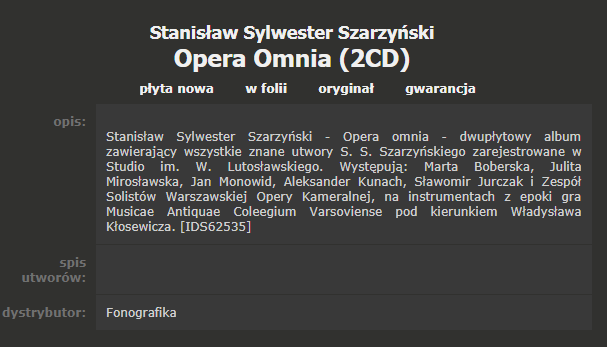
As one might expect from that period and that part of the world, there’s much research left to be done to unearth and recuperate Szarzynski’s music and appreciate its qualities. Fingers crossed that musicological research moves forward so that his music becomes more readily available. It’s worth the trouble, there’s absolutely no doubt on that account.
![]()
Mikołaj Zieleński (Polish, fl. 1611)
Here we have a very curious case on our hands. Neither the date of birth nor the date of death can be determined, the only date determinable which the floruit represents comes from the publication of his compositions in Venice. VENICE. Not Warsaw, not Dresden, not Vienna — VENICE. Go figure. From the Polish Music Center at the University of Southern California comes this information (webpage here):
Mikołaj Zieleński was a bandmaster and organist at the court of the primate Wojciech Baranowski in Lowicz. It is not known since when and for how long he was in this position. Also unknown are the dates of his birth and death. (However, Wojciech Baranowski was a primate from 1608 until 1615). Some suggested that Zieleński studied in Venice but there is no proof of that even though his works were published there. Zieleński’s preserved compositions are as follows: Offertoria totius anni and Communiones totius anni, together 122 works which were published by Vincentius in Venice in 1611. The collection of Offertoria is made up of 56 compositions. The first 44 works are based on liturgical text of offertoria. The text of the others consist of two communions, one magnificat, and nine different religious texts. Except for the Magnificat which is for 12 voices (3 choirs for 4 voices) all the other compositions are for 8 or 7 voices( 2 choirs for 4 voices, 1 choir for 4 voices, and 1 choir for 4 voices and 3 voices).
The most important years of Zieleński’s life were spent in Gniezno, the seat of the Catholic Primate of Poland and the place where Polish kings were wont to be crowned. Here’s a pic of the cathedral:
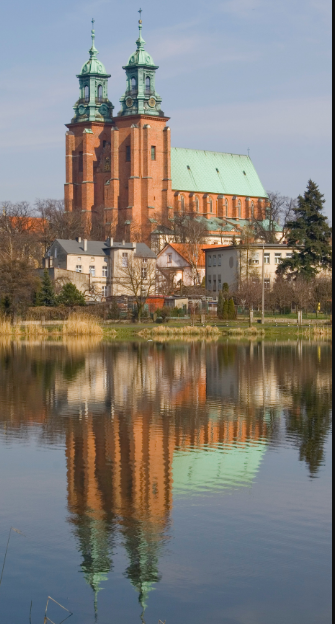
Here’s a pic of his earlier haunt, the collegiate church in Lowicz, the full name of which is one of those consonant salads for which Polish is infamous — Bazylika katedralna Wniebowzięcia Najświętszej Maryi Panny i św. Mikołaja w Łowiczu:
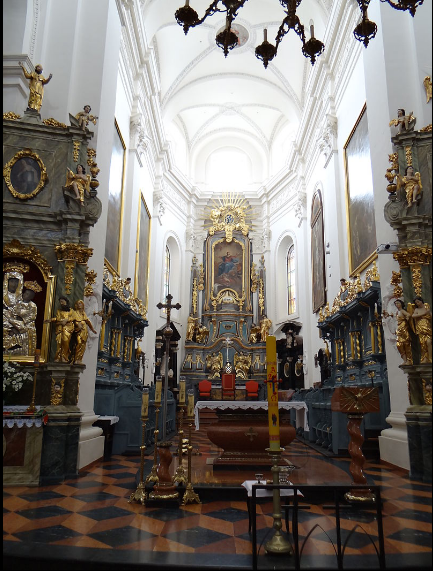
Both are very handsome buildings that no doubt happily reverberated to Zieleński’s music. It seems, however, an odd point of origin for concerted motets in the style of Gabrieli published in Venice in 1611, when the stile moderno was in its first florescence. What’s up with that?
We need to go back to the article on Polish Baroque music in the Commonwealth by Barbara Przybyszewska-Jarmińska on the website of Wilanow Palace (here):
After Marenzio’s departure and until mid-17th century, only Italian musicians (Giulio Cesare Gabussi, Asprilio Pacelli, Giovanni Francesco Anerio, Marco Scacchi) were appointed as royal bandmasters. They introduced a new style of musical compositions in the repertoire of the royal band, shaping the tastes and technique of the local musicians in the band. They also contributed to popularising Baroque music at magnate courts and in churches (in the most important church – the Wawel cathedral, the first bandmaster of the new vocal and instrumental band established in 1619 was also the Italian musician Annibale Orgas).
Italian novelties were also brought by Poles from their trips to Italy. Probably soon after returning from Rome in around 1601 the Jesuit Jan Brant composed Invitatorium in festo Nativitatis, the first known to us (incomplete) work of a Polish composer with organ bass that could be regarded as a forerunner of basso continuo, considered to be one of the determinants of Baroque music. Although no explicit evidence has been found to confirm that Mikołaj Zieliński visited Italy, it seems that his work published in the collections Offertoria et Communiones totius anni (Venice 1611), displaying certain features of Renaissance as well as Baroque music, is an important argument in favour of the hypothesis that he indeed travelled to or even studied in Italy. It was probably during his stay in Italy that Wojciech Dembołęcki (Dębołęcki) composed his Completorium Romanum (Venice 1618), the earliest surviving (unfortunately incomplete) work of the Polish composer with basso continuo with digital [i.e. numerical figured bass] markings.
The parallel we need to draw here is with the musical establishment in Dresden, a mere 411 kilometers (255 miles) from Gniezno and one of the main musical centers of the region. Our focus should be specifically on one composer of that court: Heinrich Schütz (info here):
After being a choir-boy he went on to study law at Marburg before going to Venice from 1609–1612 to study music with Giovanni Gabrieli. Gabrieli is the only person Schütz ever referred to as being his teacher. He also inherited a ring from Gabrieli shortly before the latter’s death. He subsequently was organist at Kassel from 1613 to 1615.
Particularly important is the op. 2 collection Psalmen Davids that Schütz published in 1619. These are Italianate polychoral compositions of immense sophistication and inventiveness, published in Dresden. Schütz had published his op. 1 collection of Italian madrigals earlier in Venice in 1611, exactly the same year that saw the publication of Zielenski’s collection. The number of Italian musicians working in Poland in the first half of the 17th century appears from the documentary evidence to be much larger than the number active in the German musical sphere centered around Dresden. It seems clear, then, that Italian influence was as strong or stronger in Poland than it was in the Dresden ambit.
Another composer who offers a point of comparison is Michael Praetorius (info here). He was intimately involved with the musical establishment in Dresden, as the Wikipedia page on him informs us:
When the duke [Henry Julius, Duke of Brunswick-Lüneburg] died in 1613 and was succeeded by Frederick Ulrich, Praetorius retained his employment. From 1613 he also worked at the court of John George I, Elector of Saxony at Dresden, where he was responsible for festive music. He was exposed to the latest Italian music, including the polychoral works of the Venetian School. His subsequent development of the form of the chorale concerto, particularly the polychoral variety, resulted directly from his familiarity with the music of such Venetians as Giovanni Gabrieli. The solo-voice, polychoral, and instrumental compositions Praetorius prepared for these events mark the high period of his artistic creativity. Until his death, Praetorius stayed at the court in Dresden, where he was declared Kapellmeister von Haus aus and worked with Heinrich Schütz.
Based on the evidence of Zieleński’s music he must have been cut from the same cloth as Schütz and Praetorius. Nothing else can explain the fact that his collection was published in Venice and shows the same influence of the new Italian polychoral style that we find in the musical court of Dresden.
The recording I have of Zieleński’s works is a product of the excellent teamwork of Camerata Silesia and Concerto Polacco. Here’s the cover:
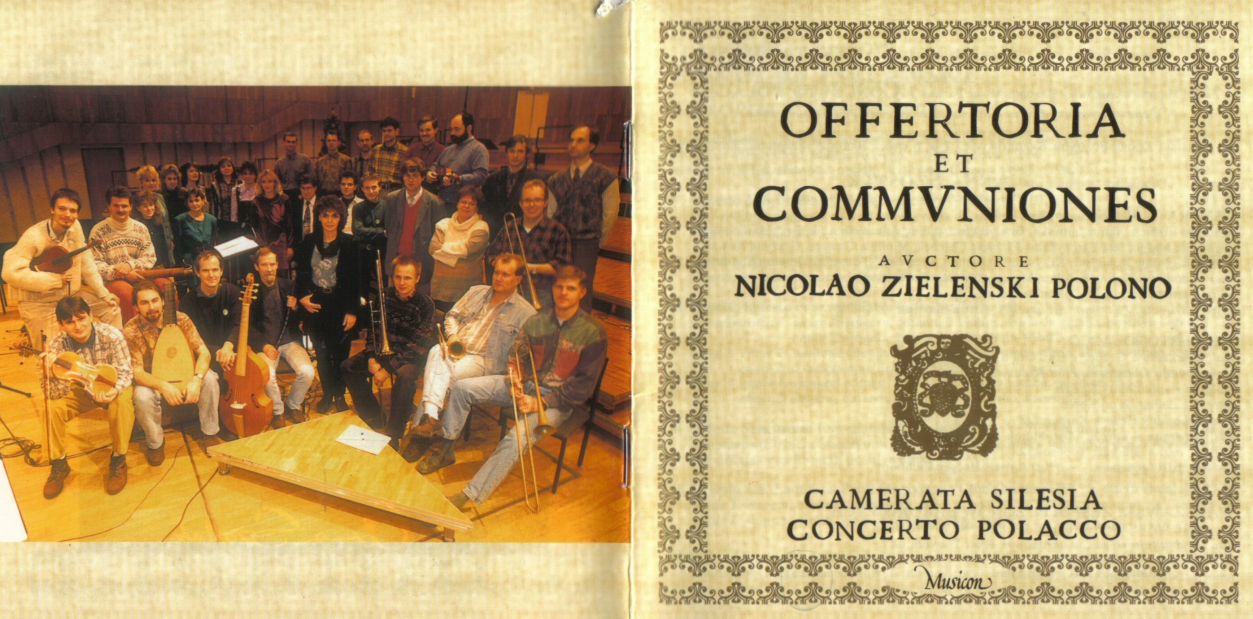
They do a great job and if you’re interested in exploring Zieleński’s music this is the go-to recording. To be completely transparent, Zieleński is not fully up to the level of Schütz or Praetorius. I say that in no mean spirit and with full respect and appreciation for Zielenski’s accomplishments, it’s just that his compositional technique seems much more tentative than that of either Schütz or Praetorius. They took the Italian models and found their musical impulses burst into flame with creative imagination, moulding the Italian idiom to the reality of their own cultural ambit and religious conventions. What they created in the first half of the 17th century still astonishes us with its breadth, inventiveness and power. That said, the joint efforts of Concerto Polacco and Camerata Silesia do a very good job of giving Zielenski’s compositions to us in the best possible light, and for that they deserve a big thumbs up. I’m very glad I have the recording because otherwise I would have missed knowing Zieleński’s music, which would be a great pity. It’s worthy of all the attention one cares to give it.
![]()
So, that’s it for the early Baroque period. You may wonder why I didn’t include any Russians in the list. Well, it’s because in the early Baroque period the Russians were in a completely different world cut off from developments in countries farther to the west, so the early Baroque in Russia produced no native sons known to us as composers in the western tradition. I’m sure there was a lot of really good Orthodox ecclesiastical chant going on, but that’s a different story. You won’t find many Russian names in Part 2 of this post, either, because the Russian court imported its musicians in the 18th century rather than growing them on native soil. I’ll keep digging and see if I can find anything to bring the Russian dimension more fully to our discussion in Part 2 — but don’t hold your breath.
I’ve already got my list made for Part 2 and there are ten composers on it, one of them a very Big Deal, indeed. So take a break, poke around and do some listening, and check back for Part 2 soon. There’s much more fun to be had with the Slavic Baroque. 🙂
